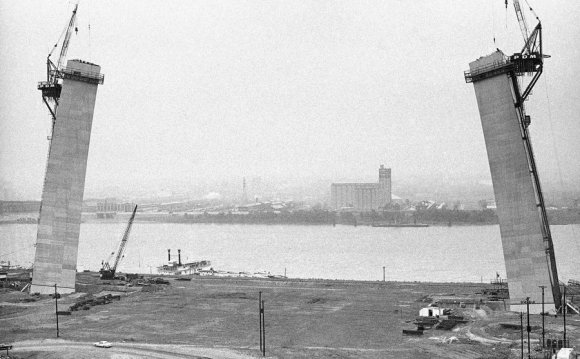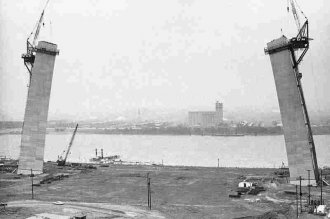

- The Gateway Arch in St. Louis was conceived in the 1940s and completed in the 1960s. It was designed to symbolize the opening of the West. Here, it is shown under construction on June 17, 1964.
Fred Waters/AP
- A 60-ton steel strut is lifted into place joining the two towers of the Arch on June 17, 1965.
AP
- The Arch nears completion as the two legs stretch to within 6 feet of their intended 630-foot height on Sept. 25, 1965.
AP
- The next-to-last 8-foot stainless steel section is fitted into the top of the Arch on Oct. 19, 1965.
AP
- Workmen close the gap on Oct. 28, 1965, as they insert a 10-ton keystone, completing three years of construction. A hydraulic jack atop the 630-foot arch forced the structure's legs apart for installation.
Fred Waters/AP
- Workmen bring the keystone section into place on Oct. 28, 1965. The crane in the background lifted the 10-ton stainless steel section. The Mississippi River is to the right.
AP
- The Gateway Arch was completed on Oct. 28, 1965. It is pictured above in 1976.
Charles W. Harrity/AP
The iconic Gateway Arch — overlooking the Mississippi River from the St. Louis side — took almost a generation to build, but the 630-foot monument hasn't transformed the city as hoped in the four decades that have followed.
Conceived in the 1940s and completed in the 1960s, the history of the signature American symbol is described in Tracy Campbell's new book, The Gateway Arch: A Biography. The story has some surprising twists — including, Campbell says, a very early vision of an arch by the Mississippi:
Geneva Abbott was a high-school student in St. Louis in 1933 and was asked to think, what should the future St. Louis look like? And she drew this gleaming — it looks like stainless steel, it's hard to see exactly what it is, maybe aluminum — but it's a shining parabolic arch parallel to the Mississippi River.
More than decade after Abbott's imaginative drawing, Eero Saarinen submitted a design for a gleaming metal curve to a competition, and the saga of the Arch began. Campbell, a history professor and the co-director of the Wendell Ford Public Policy Research Center at the University of Kentucky, joins NPR's Scott Simon to talk about the controversy around the design, the African-American residents who were displaced to build the Arch and whether the monument really symbolizes the opening of the West.
Interview Highlights
On how Eero Saarinen, an architect working in Detroit, came up with the design for the Gateway Arch
"He entered the competition with over 170 other designers. If you could win this competition it would be about $40, 000 for the first prize — which in the 1940s was a tremendous amount of money — and it was the most prestigious architectural competition in the world at the time. And he came up with the idea of building a freestanding arch.
"First he thought it might be made of concrete; eventually he came up with the idea of stainless steel. It was originally four-sided, but a sculptor who had worked with Rodin convinced him that it ought to be three-sided. So over time it became a much more beautiful work of art, a sculpture. And that was Eero Saarinen's first love, really, was sculpture rather than architecture.
"And right after the competition in which Eero Saarinen won ... Adalberto Libera threatened to sue him. Libera was an Italian architect who said that this was actually a fascist symbol that he had designed for the 1942 Rome Exposition. And there was a great deal of controversy in the weeks surrounding the competition ... would Saarinen's Arch be shelved, because it was stolen? Saarinen of course denied it, and said, 'How can anyone really claim credit for what has been around for thousands of years? It's universal, in so many ways.' "
The Gateway Arch "is really a monument to the 20th century and to the height of American power, " says historian Tracy Campbell. Joe Raedle/Getty Images hide caption
toggle caption Joe Raedle/Getty ImagesThe Gateway Arch "is really a monument to the 20th century and to the height of American power, " says historian Tracy Campbell.
Joe Raedle/Getty ImagesRELATED VIDEO




 Benevento listen (help·info) is a town and comune of Campania, Italy, capital of the province of Benevento, 50 kilometres (31 mi) northeast of Naples. It is situated on a hill 130 metres (430 ft) above sea-level at the confluence of the Calore Irpino (or...
Benevento listen (help·info) is a town and comune of Campania, Italy, capital of the province of Benevento, 50 kilometres (31 mi) northeast of Naples. It is situated on a hill 130 metres (430 ft) above sea-level at the confluence of the Calore Irpino (or...








